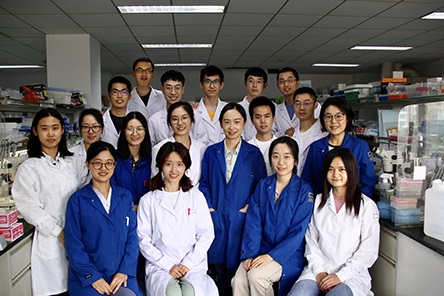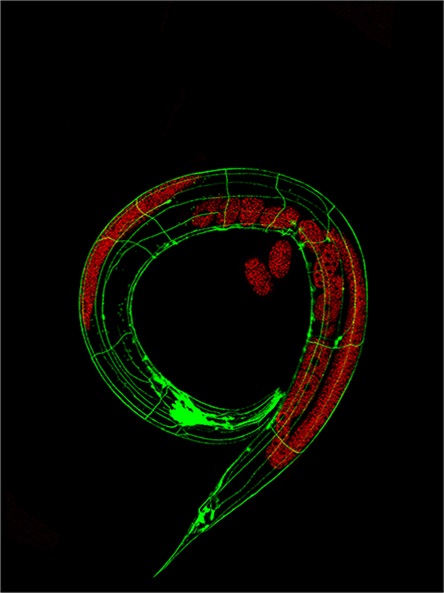Ye Tian investigates how mitochondrial stress signaling pathways regulate longevity using C. elegans as a model system.
An avid reader, Ye Tian used to save up her child allowance with the sole purpose of buying science fiction books. Reading and solving mathematical problems were her favorite hobbies; indeed, she liked mathematics so much that she was about to enroll herself as an architecture major but finally chose biotechnology. Ye moved from her hometown in the Northwest of China, Baoji—famous for housing the Zhou dynasty’s bronzeware and being close to the Terracotta Army—to Beijing for her college and graduate studies.
Ye is proud of being among the earliest researchers working on Caenorhabditis elegans in her country; for her PhD studies, she joined the lab of Hong Zhang, who at that time has just established the first C. elegans lab in China at the National Institute of Biological Sciences in Beijing. Ye identified epg-2 as an adaptor for cargo recognition during autophagy. In 2010, she crossed the Pacific toward the U.S. West Coast for her postdoctoral training in the aging field with Andrew Dillin, first at the Salk Institute in San Diego and then at the University of California, Berkeley. There, she discovered that mild mitochondrial stress during development in worms rewires their chromatin landscape to establish specific gene expression patterns throughout the lifespan and promote longevity.
Ye Tian. Photo courtesy of Ye Tian.
Ye came back to China at the end of 2016 to start her own lab at the Institute of Genetics and Developmental Biology of the Chinese Academy of Sciences. Her research team studies mitochondrial stress signaling pathways and their interplay with aging. We chatted with her to learn more about her next scientific plans.
What interested you about the interplay between mitochondria and aging?
I became interested in mitochondrial biology during my postdoc in Andrew Dillin’s lab. Since the origin of eukaryotic cells, mitochondria have been a driving force of evolution. During reproduction, mitochondria are passed from the mother to the offspring through egg cells and they exhibit a unique inheritance pattern. As essential hubs that dictate cellular metabolism, it is clear now that mitochondria and the nucleus maintain a bidirectional communication. Early life “stressed” mitochondria communicate with the nucleus to induce gene expression changes that are beneficial on longevity and persist throughout the lifespan. The fact that mitochondrial function is crucial to aging fascinated me; I wanted to continue exploring that topic further, and that’s why I established my lab around the question of how mitochondrial surveillance mechanisms regulate the aging process.
What are you currently working on? What is up next for you?
My research team focuses on the interplay between mitochondrial stress signaling pathways and aging. The first work that my lab published was a project that I started during my postdoc. The Dillin lab reported a phenomenon in which perturbations of mitochondria in neurons induced a mitochondrial stress response in the peripheral tissues and hypothesized that a secreted signal molecule, named after mitokine, is required for the cell non-autonomous regulation (
1). The identity of this molecular signal remained elusive for almost ten years until we found that a secreted Wnt ligand, EGL-20, functions as the mitokine to coordinate mitochondrial stress signaling across tissues and promote longevity of the organism (
2). We are also interested in how the crosstalk between mitochondria and the nucleus influences lifespan. We found that mitochondrial perturbations alter the nuclear epigenome to induce longevity via the histone deacetylation complex NuRD in response to cellular acetyl-CoA levels, the key metabolite at the entry point of the Krebs cycle (
3).

Lab group picture; current lab members (2021). Photo courtesy of Ye Tian.
Our latest work stemmed from a serendipitous observation that neuronal mitochondrial stress is sensed by and transmitted through the mitochondria in the germline. Intergenerational, maternal inheritance of elevated levels of mitochondrial DNA via the mitokine Wnt/EGL-20, which causes the activation of the mitochondrial unfolded protein response (UPR
mt), provides descendants with a greater tolerance to environmental stress. This makes the offspring live longer (
4).
Among our short-term scientific plans, we’re determining how mitochondria functions during the aging process at both the genetic and biochemical levels and searching for ways to apply our findings from C. elegans to neurodegenerative disease models in mammals.
What kind of approach do you bring to your work?
The curiosity about how things work drives me; what I enjoy the most is when I see things happening in front of my eyes and when I figure out why they occur that way. That enthusiasm is what I try to spread to my team every day. In the lab, we rely on C. elegans as our model system and on genetics to dissect complex biological processes like aging. We have also adapted modern biochemical and imaging techniques as well as bioinformatics to complement our genetic studies. I’m a geneticist at heart, and I like to initiate a project with a well-designed genetic screen. The best part is that the screen often leads me to answers I was not expecting, and that’s genuinely inspiring!
What did you learn during your PhD and postdoc that helped prepare you for being a group leader? What were you unprepared for?
Like most scientists, my research career has gone through ups and downs. I had to change my research project in the last year of my graduate school; that was nerve-racking, but I eventually managed to redirect my thesis and get exciting results under time pressure, thanks in large to the support of my parents, mentors, and lab mates. That helped me prepare to become a principal investigator; I gained confidence in problem solving, and since I’ve experienced the stress of dealing with last-minute scope changes firsthand, I connect better with my students.
I guess, as many other non-native English speakers, I wasn’t prepared for writing grants and papers fluently in English. This issue wasn’t obvious during my graduate and postdoctoral studies, as my mentors were always there for me and proofread and edited my writing. Now I have to stand up for myself. I spend most of my time writing; I’ve improved my writing skills but it’s still an ongoing process.
Reconstruction of the nerve system of C. elegans by confocal microscopy. Green corresponds to YFP-labeled neuronal specific marker Q40, and red labels germline specific mitochondrial outer membrane protein TOMM-20::mkate2. Image courtesy of Ye Tian’s lab.
What has been the biggest accomplishment in your career so far?
My very first PhD student, Qian Zhang, graduated with two first-author papers and decided to pursue a research career in academia. Being responsible for someone else’s career is challenging but also rewarding.
What has been the biggest challenge in your career so far?
I use the model organism C. elegans for my research in aging, so from time to time, peers criticize the relevance of my work to human health. I’m used to justifying my scientific approach to funding agencies and peers in other fields, but sometimes it’s exhausting or not pleasant.
Who were your key influences early in your career?
My PhD mentor, Hong Zhang. He is very passionate about the science he does, and he is courageous to shift his research directions to answer new biological questions.
What is the best advice you have been given?
I think the best advice I’ve gotten is that “tomorrow is another day.” It reminds me to keep going and be optimistic.
What hobbies do you have?
I love art and music. When I was in San Diego, I used to play in the Chinese Music Band; I miss my musician friends over there. In my teens, I used to hike mountainside trails along the river with my parents. Now, running has become my new favorite hobby. I enjoy the tranquility and peace of mind while running; it’s soothing.
 Ye Tian. Photo courtesy of Ye Tian.Ye came back to China at the end of 2016 to start her own lab at the Institute of Genetics and Developmental Biology of the Chinese Academy of Sciences. Her research team studies mitochondrial stress signaling pathways and their interplay with aging. We chatted with her to learn more about her next scientific plans.
Ye Tian. Photo courtesy of Ye Tian.Ye came back to China at the end of 2016 to start her own lab at the Institute of Genetics and Developmental Biology of the Chinese Academy of Sciences. Her research team studies mitochondrial stress signaling pathways and their interplay with aging. We chatted with her to learn more about her next scientific plans. Lab group picture; current lab members (2021). Photo courtesy of Ye Tian.Our latest work stemmed from a serendipitous observation that neuronal mitochondrial stress is sensed by and transmitted through the mitochondria in the germline. Intergenerational, maternal inheritance of elevated levels of mitochondrial DNA via the mitokine Wnt/EGL-20, which causes the activation of the mitochondrial unfolded protein response (UPRmt), provides descendants with a greater tolerance to environmental stress. This makes the offspring live longer (4).Among our short-term scientific plans, we’re determining how mitochondria functions during the aging process at both the genetic and biochemical levels and searching for ways to apply our findings from C. elegans to neurodegenerative disease models in mammals.
Lab group picture; current lab members (2021). Photo courtesy of Ye Tian.Our latest work stemmed from a serendipitous observation that neuronal mitochondrial stress is sensed by and transmitted through the mitochondria in the germline. Intergenerational, maternal inheritance of elevated levels of mitochondrial DNA via the mitokine Wnt/EGL-20, which causes the activation of the mitochondrial unfolded protein response (UPRmt), provides descendants with a greater tolerance to environmental stress. This makes the offspring live longer (4).Among our short-term scientific plans, we’re determining how mitochondria functions during the aging process at both the genetic and biochemical levels and searching for ways to apply our findings from C. elegans to neurodegenerative disease models in mammals. Reconstruction of the nerve system of C. elegans by confocal microscopy. Green corresponds to YFP-labeled neuronal specific marker Q40, and red labels germline specific mitochondrial outer membrane protein TOMM-20::mkate2. Image courtesy of Ye Tian’s lab.
Reconstruction of the nerve system of C. elegans by confocal microscopy. Green corresponds to YFP-labeled neuronal specific marker Q40, and red labels germline specific mitochondrial outer membrane protein TOMM-20::mkate2. Image courtesy of Ye Tian’s lab. CAS
CAS
 中文
中文




.png)
